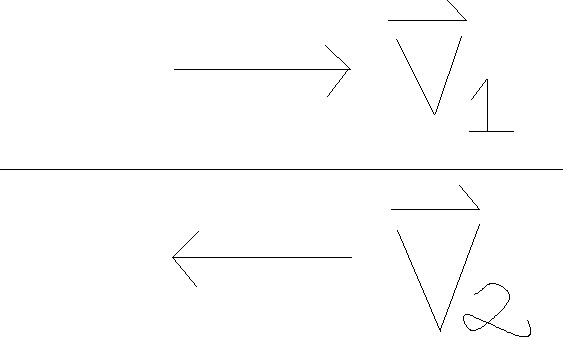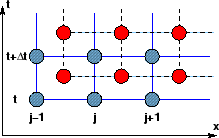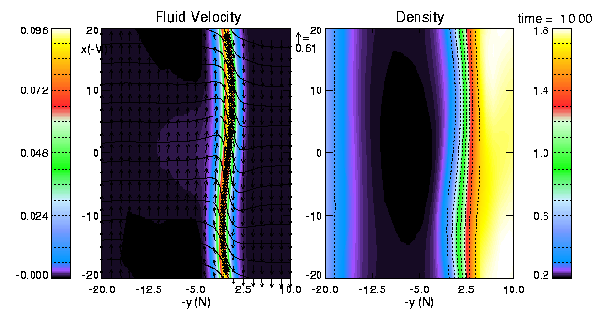2-D Simulation of the Kelvin-Helmholtz Instability
What, exactly, is an instability, anyway?
A bit about the science involved
The simulation
Some results
Conclusions
What, exactly, is an instability, anyway?
An
Instability is an unstable response to a small perturbation. For
an instability to occur, a system must have a source of free energy.
Once this small perturbation to the initial equilibrium is
applied, the instability will grow in amplitude in non-equilibrium
stages---fed by the sources of free energy.
A bit about the Kelvin-Hemholtz Instability
The free
energy for the Kelvin-Helmholtz is provided by the kinetic energy of
the anti-parallel velocity components  across a plane boundary:
across a plane boundary:

An ordinary
inviscid fluid is alway KH unstable in the presence of a velocity
shear, and its growth rate--for the simple case with uniform
density--is given by  , where
, where  is the difference of the velocities across the shear flow layer and
is the difference of the velocities across the shear flow layer and  is the wave number. This indicates that for short wave lengths (small
is the wave number. This indicates that for short wave lengths (small  )
the instability grows quickly, and that large velocity shear increases
the growth rate. When two shear fluid streams are adjacent to
each other, the flow can be perturbed by even infintessimal
perturbations. Fluid Kelvin-Helmholtz vortices can always be seen
when a velocity shear is present: in uprising cigarette smoke; at the
intersection of two rivers (i.e. the Chena and Tanana river in Alaska);
on the ocean and in lakes; in a coffeee cup when one pours cream into
it; and in cloud formations:
)
the instability grows quickly, and that large velocity shear increases
the growth rate. When two shear fluid streams are adjacent to
each other, the flow can be perturbed by even infintessimal
perturbations. Fluid Kelvin-Helmholtz vortices can always be seen
when a velocity shear is present: in uprising cigarette smoke; at the
intersection of two rivers (i.e. the Chena and Tanana river in Alaska);
on the ocean and in lakes; in a coffeee cup when one pours cream into
it; and in cloud formations:

"Cat's eyes"---photo credited to Kim Witting
Also, airplane
wings can "stall" when the critical angle of attack is exceeded--due to
turbulence produced by the Kelvin-Helmholtz instability.
The Simulation.
The simulation
was serial, written in FORTRAN (visualizations routines written in
IDL), and used a "leapfrog" (Dufort-Frankel) fitting scheme for the
main integration:


A Lax-Wendroff scheme is used on output cycles---to fill in the "gaps."
When
surface tension was desired between the two sheared layers, it was
calculated from the [rate of] curvature of the boundary---the location
of which was kept track of numerically.
Results
For
the "production run," two inviscid, compressible fluids were chosen.
(The parameter file could be easily adjusted to account for these
changes.)

Conclusions
The simulation was able to very nicely reproduce--at least qualitatively--a Kelvin-Helmholtz instability.
Unfortunately, I was not
able to create/reproduce the ?self-similar?, smaller, Kelvin-Helmholtz
vortex along the boundary---and this was one of the things for which I
was looking. I honestly don't know if this was due to a
limitation in the resolution of the code--or if this model could not
produce it. This leaves some potential further investigation. . .
.
Credit where credit is due:
The
original simulation was written by Dr. Antonius Otto and Dr. Katariina
Nykyri. The original IDL visualization routines were also written
by Dr. Katariina Nykyri---with some sections possibly having been
written by Dr. Antonius Otto.

back.
 across a plane boundary:
across a plane boundary:



